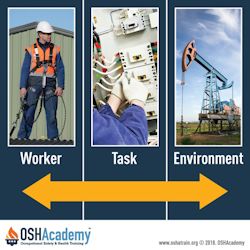Identifying Ergonomic Hazards
What is Ergonomics?
Ergonomics involves finding ways to work easier and just as productively.The goal of the science of ergonomics is to find the best fit between the worker and job conditions. Ergonomics tries to come up with solutions to make sure workers stay safe, comfortable, and productive.
Ergonomics also means working smarter, not harder. It looks at the following risk factor categories to see how the job can best fit the worker:
- Risk factors inherent in the worker: Physical, psychological, and non-work-related activities may present unique risk factors.
- Risk factors inherent in the task: Work procedures, equipment, and workstation design may introduce risk factors.
- Risk factors inherent in the environment: Physical and psychosocial "climate" may introduce risk factors.
Ergonomic hazards can cause painful and disabling injuries to joints and muscles in various general industry jobs, especially in manual material handling. According to the Occupational Safety and Health Administration (OSHA), ergonomic hazards are the most frequently occurring health hazards in all industries and the cause of most injuries.
In a recent survey, 40 percent of construction workers said that 'working hurt' is a major problem. Working hurt reduces productivity, but continuing to work hurt can result in disabling injuries that end a career. Many laborers retire by age 55 because they just can't do the work anymore. Many cannot enjoy their retirement because of their disabilities.
In 2023, a multinational company was cited by OSHA at three of its warehouses.
Federal officials found workers exposed to ergonomic hazards such as being at high risk of lower back injuries and musculoskeletal disorders. Strenuous warehouse working conditions, which require employees to lift heavy packages for long hours, often in “awkward postures,” contributed to the hazards, OSHA said.
The same company was cited for exposing workers to danger of being struck by falling boxes. They face a separate investigation for failing to record and report injuries and illnesses in a proper and timely manner.
The company disputed that a focus on productivity rates have led to high injury rates. They face ongoing federal probes into their workplace safety record, and fines upwards of $60,000.
Knowledge Check Choose the best answer for the question.
1-1. Which of the following is not one of the general risk factor categories?
You forgot to answer the question!

